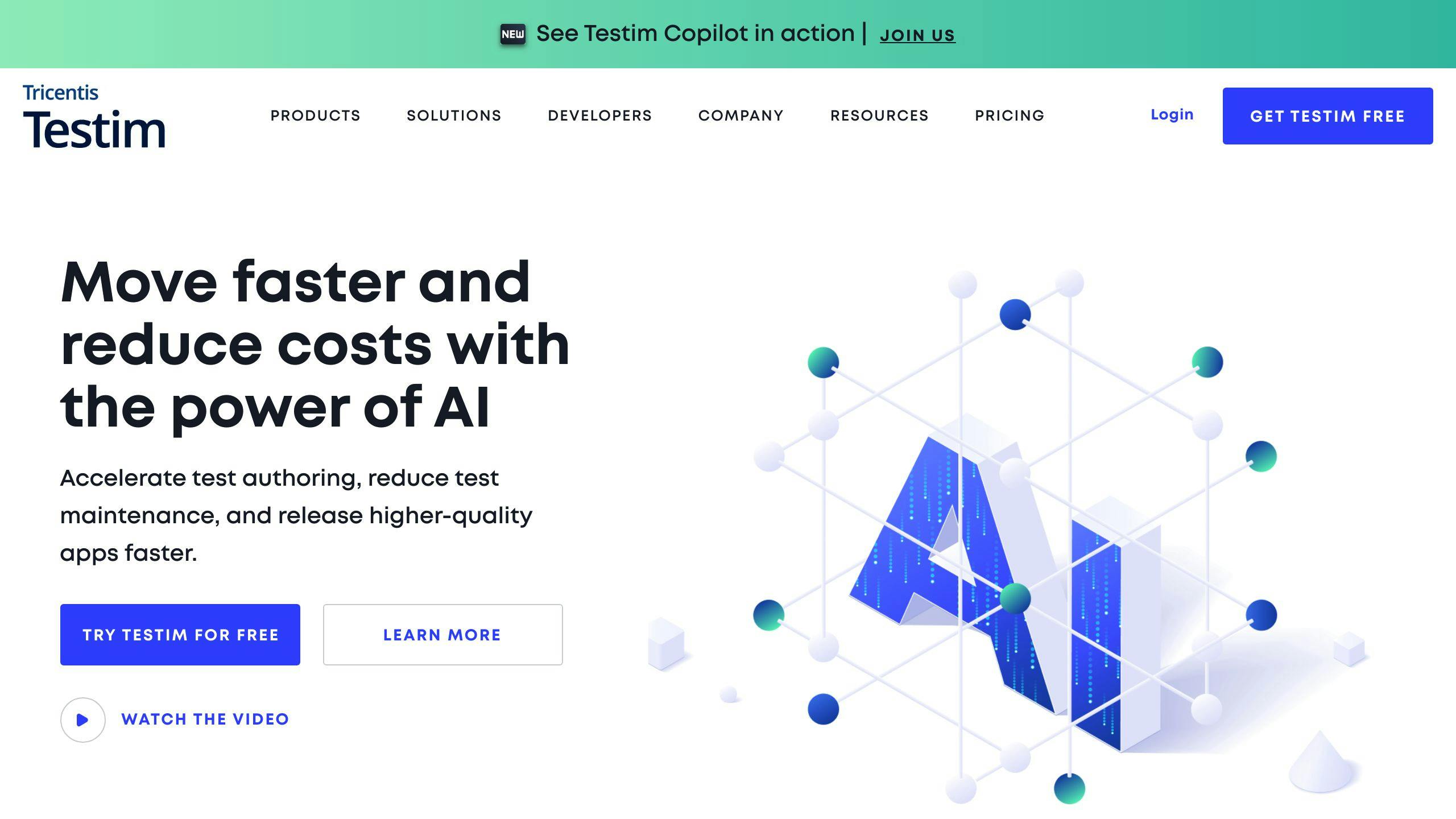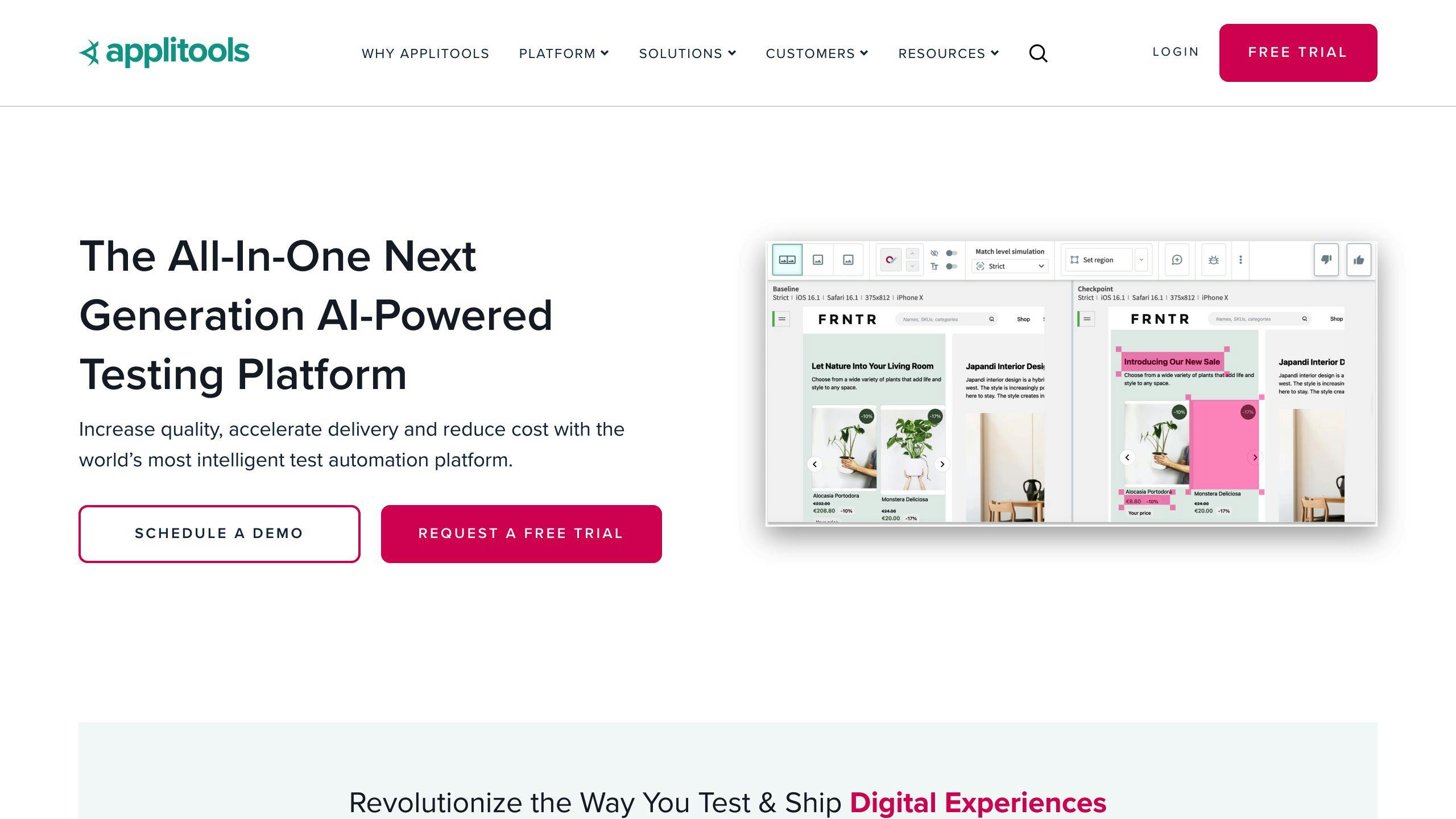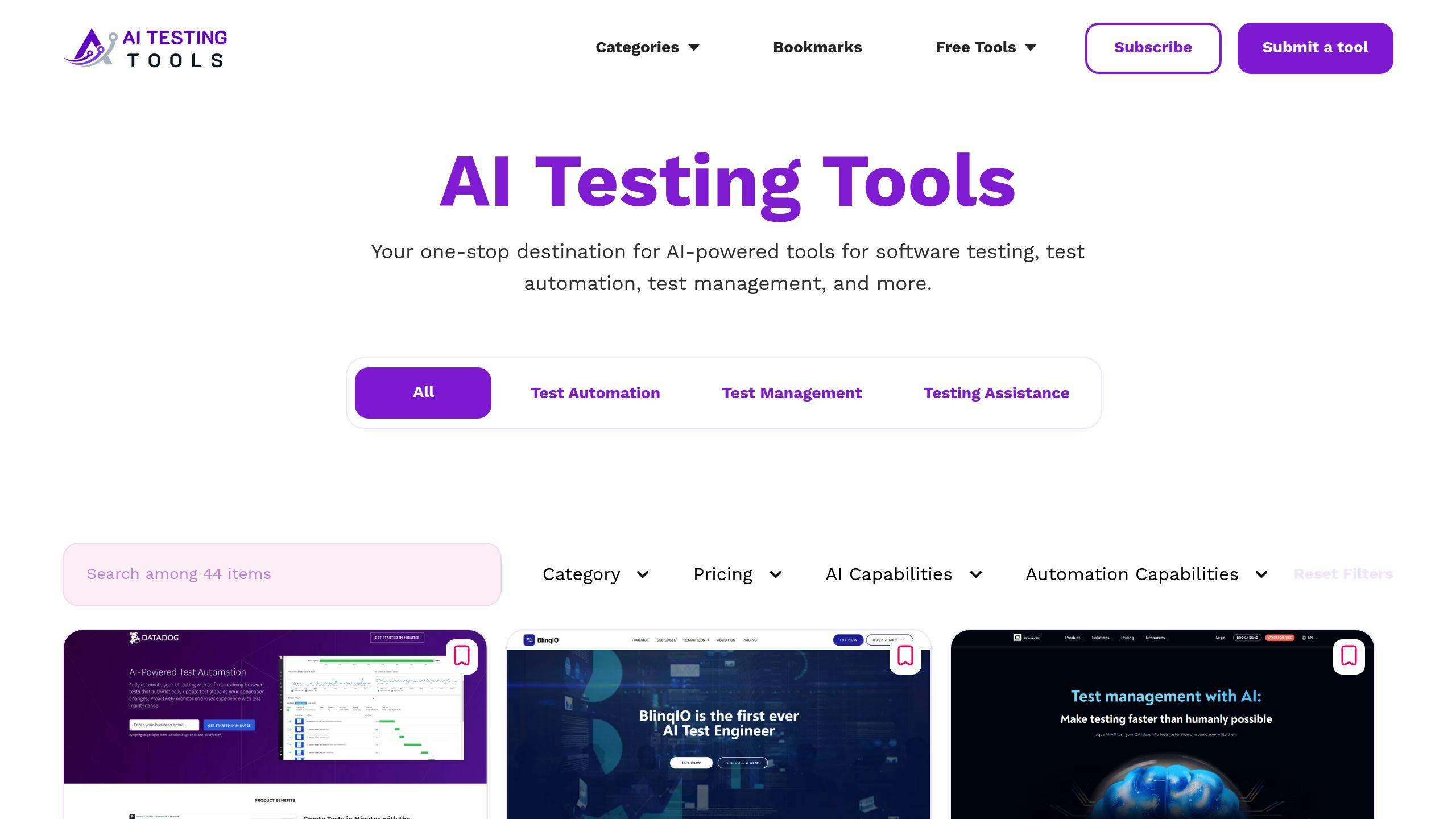Self-healing tests are transforming software testing by using AI to fix broken tests automatically. Unlike traditional tests that fail when a UI changes, self-healing tests adapt in real-time, reducing maintenance efforts and keeping tests reliable.
Key Benefits:
- Automatic Repairs: AI identifies and updates broken locators without manual intervention.
- Reduced Maintenance Costs: Saves time and resources by cutting manual updates by up to 60%.
- Improved Test Reliability: Ensures tests fail only for actual defects, not minor UI changes.
- Faster Feedback: Keeps CI/CD pipelines running smoothly by adapting instantly to changes.
How It Works:
- Multi-attribute Analysis: AI examines multiple properties of elements (ID, text, position, etc.).
- Dynamic Signature Creation: Builds flexible patterns to track and adapt to changes.
- Learning from Past Runs: Continuously improves by analyzing execution patterns.
Challenges:
- Struggles with complex workflows or conditional logic.
- Risk of false positives/negatives requires close monitoring.
Self-healing tests are essential for modern, fast-paced development environments, enabling teams to focus on innovation instead of tedious maintenance tasks.
Understanding Self-Healing Test Automation
What Are Self-Healing Tests?
Self-healing tests tackle the maintenance headaches caused by application changes. Unlike traditional tests that fail when interface elements are updated, self-healing tests use AI to adjust automatically. For instance, if a login button's ID changes from btnLogin to btnUserLogin, a traditional test would break. A self-healing test, however, identifies the button’s purpose and updates itself to keep running smoothly [1]. This approach directly addresses the UI maintenance challenges discussed earlier.
How AI Enables Self-Healing Tests
AI drives self-healing tests by analyzing multiple attributes of interface elements, rather than relying on a single locator. This method ensures more reliable recognition, even when elements evolve [3].
Here’s how it works:
- Multi-attribute analysis: Examines multiple properties of an element for identification.
- Dynamic signature creation: Builds flexible patterns to track changes.
- Execution pattern learning: Learns from past runs to improve accuracy.
- Context-aware recognition: Understands the broader context to identify elements.
The table below highlights the difference between traditional locators and AI-powered recognition:
| Traditional Locator | AI-Enhanced Recognition |
|---|---|
| Single fixed ID | Multiple dynamic attributes |
| Static XPath | Context-aware patterns |
| Exact match required | Fuzzy matching allowed |
| Manual updates needed | Automatic adaptation |
Comparing Traditional and Self-Healing Automation
Traditional tests rely on fixed locators and fail when UI elements change, requiring manual updates. Self-healing tests, on the other hand, adjust on their own using AI [2][4]. This aligns with AccelQ's observation that static scripts often break when UI changes occur [2].
Key differences include:
- Element Recognition: Traditional methods depend on fixed locators, while self-healing tests use dynamic and flexible identification.
- Failure Handling: Traditional tests stop working when elements change, whereas self-healing tests attempt to resolve issues automatically.
Mechanics of Self-Healing Tests
Identifying Elements Dynamically
Self-healing tests use AI and machine learning to detect UI elements dynamically, even when their properties shift. Unlike traditional methods that depend on fixed locators, these tests analyze multiple attributes at once, ensuring more reliable element recognition.
Dynamic identification involves three main processes:
1. Multi-attribute Analysis
These tests evaluate various properties of an element, such as:
- ID and class attributes
- Text content and nearby elements
- Visual traits
- Positional relationships
- Context of surrounding elements
This detailed analysis directly supports the automated repair process.
2. Smart Pattern Recognition
When an element's properties are altered, the AI explores alternative patterns to locate it. This involves reviewing the element's context, appearance, and role within the application to ensure accurate identification [1].
Repairing Scripts Automatically
Once elements are identified, the self-healing tests take over with an automated recovery process:
The repair process involves:
- Detecting locator failures
- Analyzing the application's state
- Updating locator strategies
- Validating repairs and learning from outcomes
According to Testim case studies, this approach can cut maintenance efforts by 60% [3]. The system continuously improves by learning from successful repairs, making it better equipped to handle future changes [3].
Additionally, the self-healing mechanism monitors structural relationships, effectively managing multiple simultaneous changes [4].
Advantages of Self-Healing Tests
Lowering Test Maintenance Costs
Self-healing tests drastically cut down on the need for manual script maintenance. By automating the repair process, they allow testers to concentrate on creating new test cases and planning strategies instead of spending time fixing broken tests. This shift reduces overall maintenance costs [1][2].
Here’s why it works:
- Automated repairs handle issues without human intervention.
- Dependence on specialized personnel is reduced.
- Testing delays are minimized, keeping projects on track.
- The likelihood of defects slipping through is significantly lowered.
Boosting Test Reliability
Self-healing mechanisms improve test reliability by ensuring tests fail only when there’s a real defect, not because of minor interface tweaks. AI-driven systems keep tests stable, even as applications evolve [1][4].
This reliability is particularly important in managing the increasing complexity of software. The result? Fewer false positives, stable tests, and precise defect detection - all achieved without manual adjustments.
Accelerating Feedback Loops
These tests speed up feedback by adapting to application changes automatically. This means no interruptions, allowing development teams to get immediate insights [1][4].
Here’s how they make it happen:
- Tests adjust instantly to changes in the application.
- Downtime is kept to a minimum.
- New features are validated quickly.
- Continuous improvement cycles are supported.
This seamless process keeps CI/CD pipelines running smoothly, which is essential for agile development. Faster feedback means teams can handle changes in complex systems more effectively, meeting the demands of modern software development.
Self-Healing Automation - Web UI Testing
sbb-itb-cbd254e
Tools for Self-Healing Test Automation
These tools handle self-healing automation using various technical methods:
Testim

Testim uses AI to identify locators, making automation smarter and more adaptable to changes [1][3]. Its pattern recognition supports dynamic signature creation, as previously discussed [1][3].
Key features include:
- Multi-attribute element detection
- Automatic updates for UI changes
- Built-in CI/CD integration
- Learning from execution patterns
Applitools

Applitools integrates visual AI with traditional automation to tackle the challenges of changing UIs in complex systems [4]. Its visual-first approach ensures seamless handling of interface updates.
The platform offers:
- Element recognition across devices
- Automatic adjustments to visual changes
- Cross-browser layout validation
AI Testing Tools Directory

The AI Testing Tools Directory (testingtools.ai) helps users find tools based on:
- Self-healing functionalities
- Integration needs
- Supported platforms
- Pricing options
Challenges of Self-Healing Tests
Self-healing tests are great at managing UI changes, but they can stumble when it comes to more intricate business logic.
Handling Complex Application Logic
Applications with complex workflows and interdependent states can be tricky for self-healing algorithms, especially when conditional logic or frequent UI updates are involved.
Some key challenges include:
- Dynamic UI Elements: Interfaces that change often require advanced detection techniques to keep up.
- State Management: Workflows with multiple, interconnected states can confuse algorithms, particularly with branching paths or conditional scenarios.
Managing False Positives and Negatives
Even with advanced AI, misleading test results remain a concern. False positives and negatives can undermine trust in the system, so teams must stay alert.
To reduce these risks, teams can:
- Use a variety of validation methods
- Regularly review and audit AI decisions
- Continuously train and refine AI models
It's important to monitor systems closely, tracking metrics like false positives, false negatives, and the accuracy of self-healing actions. Fine-tuning AI models to match the specific needs of your application is critical for achieving reliable performance [1][4]. Strategic planning is essential to get the most out of AI-driven test automation.
Best Practices for Adopting Self-Healing Tests
Choosing the Right Test Cases
To make self-healing tests effective, focus on cases that often fail due to UI updates or require ongoing maintenance for critical workflows. Here's what to look for:
- Tests that frequently fail because of changes in element locators.
- Workflows vital to your business that demand consistent reliability.
- Cases that need extensive manual upkeep.
- Scenarios involving dynamic elements (as explained in the Mechanics section).
Combining Automation with Human Oversight
Self-healing tests can save time, but they still need a human touch. Balancing automated processes with manual review ensures your tests stay accurate and aligned with business goals.
Key areas for oversight:
- Test Purpose: Confirm that the test aligns with business objectives.
- Element Decisions: Evaluate key decisions made during the healing process.
- Error Patterns: Analyze recurring issues to help improve AI learning.
- Quality Checks: Ensure the automated healing is accurate and reliable.
Continuous Monitoring and Improvement
Keep an eye on metrics like healing success rates, accuracy, and time saved on maintenance. False positives and negatives, as highlighted in the Challenges section, deserve special attention.
Best practices include:
- Regularly reviewing decisions made by the healing process.
- Adjusting detection thresholds as needed.
- Tracking performance metrics over time.
- Refining algorithms to improve reliability.
Using tools from the Testing Tools Directory can help you monitor these metrics effectively. Regular audits and adjustments will ensure your tests remain dependable while reducing the need for manual intervention.
Future of Self-Healing and AI-Driven Testing
Advancing Machine Learning in Testing
Modern machine learning (ML) algorithms are stepping beyond basic pattern recognition. These advanced systems are designed to understand and automatically adjust to changes in applications over time [1][3].
Here’s how ML is transforming testing:
- Learning from past test executions: Gaining insights from historical data to improve future testing.
- Spotting application change patterns: Recognizing trends and shifts in the application.
- Adapting scripts automatically: Updating test scripts without manual intervention.
- Predicting failures: Foreseeing potential issues before they occur.
Predictive Analytics for Smarter Testing
Predictive analytics is adding another layer to self-healing by helping teams foresee failures and address them early [4]. This approach builds on earlier monitoring strategies, enabling more proactive problem-solving.
Practical uses include:
- Prioritizing tests based on risk: Focusing on areas more likely to fail.
- Streamlining execution schedules: Running tests at optimal times.
- Spotting anomalies in execution: Identifying unusual patterns that could signal issues.
Self-Healing in Fast-Paced Testing Environments
In today’s fast-moving DevOps workflows, self-healing has become a must-have. With rapid deployment cycles, tests need to be reliable and easy to maintain. These self-healing capabilities directly support the quicker feedback loops essential for continuous testing [2][4].
Integrating self-healing tests into continuous testing processes makes testing more resilient and aligned with fast development cycles [1][3]. This ensures testing keeps pace with the speed of modern software development.
Conclusion: Transforming Testing with AI
Self-healing test automation is changing the way we handle the challenges of modern software development. By using AI, it reduces the need for constant maintenance and improves overall reliability [1][2]. These advancements are reshaping how teams manage quality assurance.
Here’s how these systems improve workflows:
- Fewer false positives, leading to more accurate results
- Faster feedback cycles, keeping development agile
- Support for continuous testing, even in high-speed environments
- Shifting focus from maintenance tasks to creating new tests
As machine learning continues to advance, these systems are becoming even better at predicting and preventing issues. Combined with predictive analytics and CI/CD integration [1][4], they address many of the problems tied to traditional automation. This makes self-healing tests a key element in modern software quality assurance.



